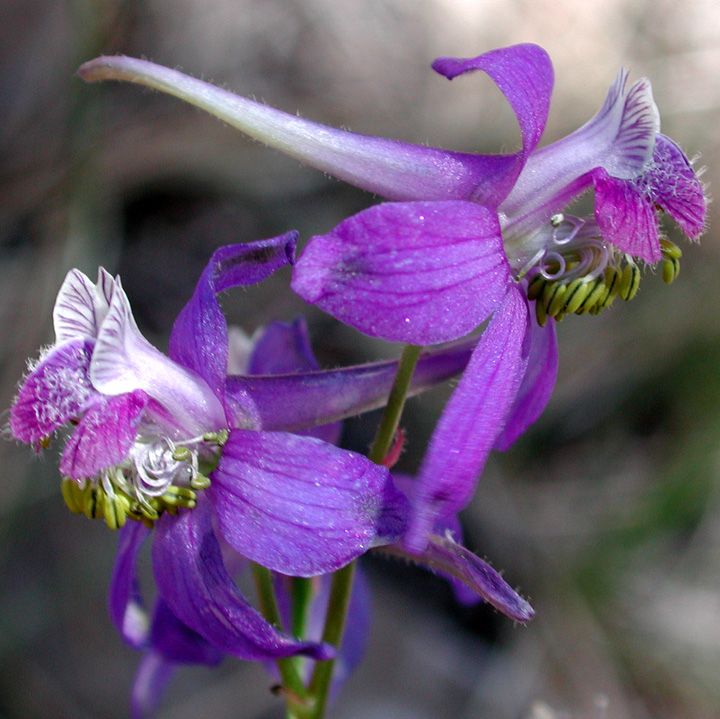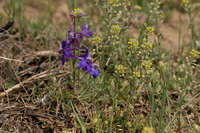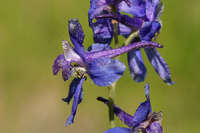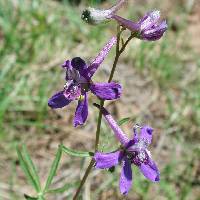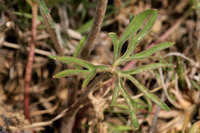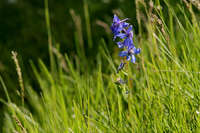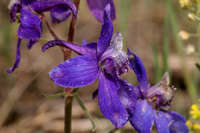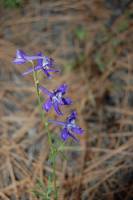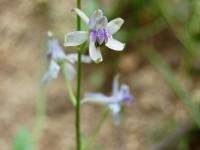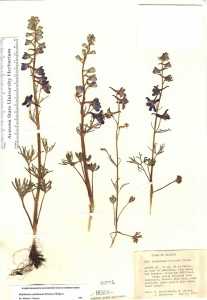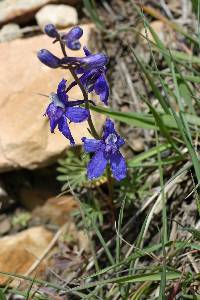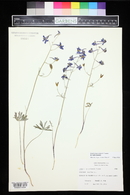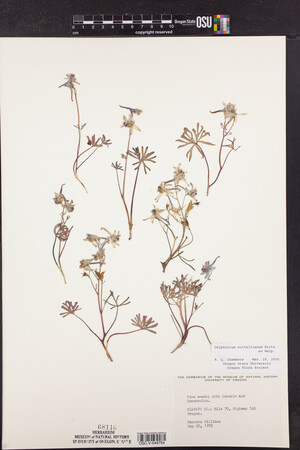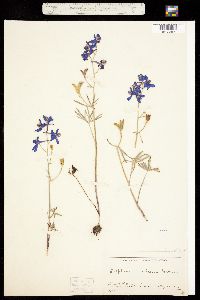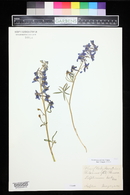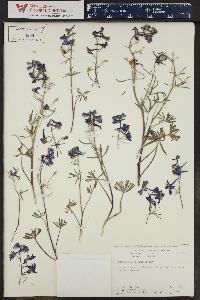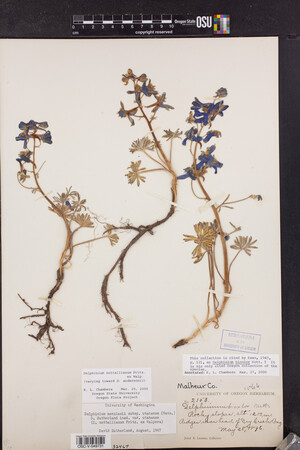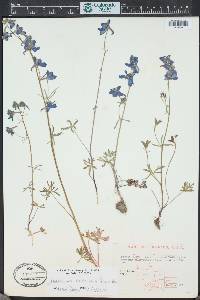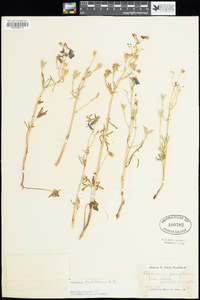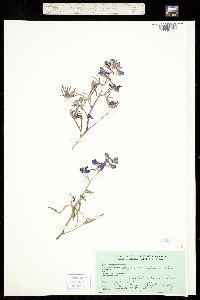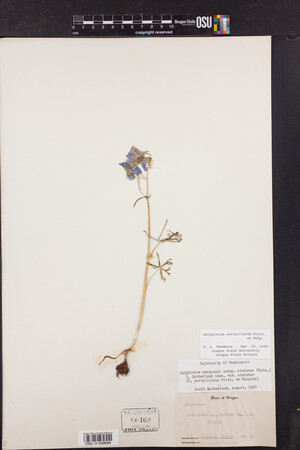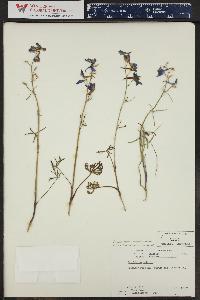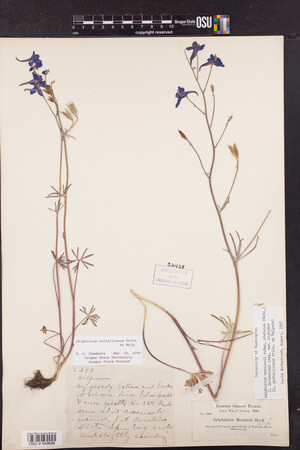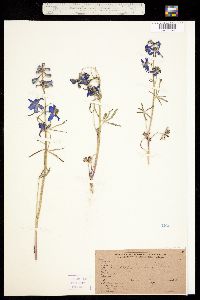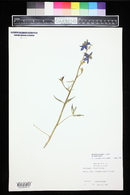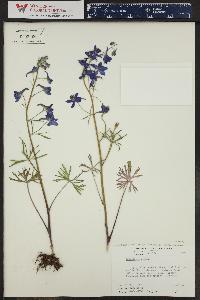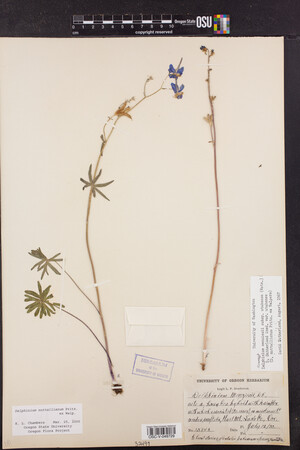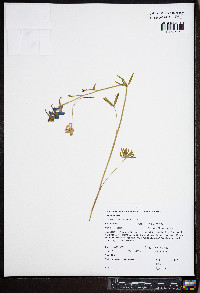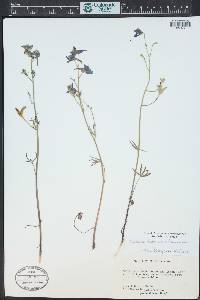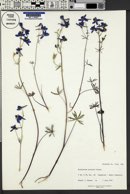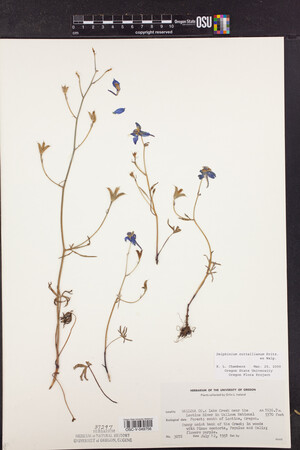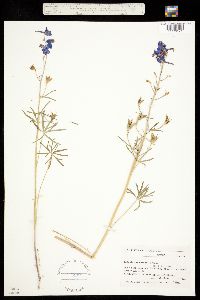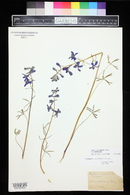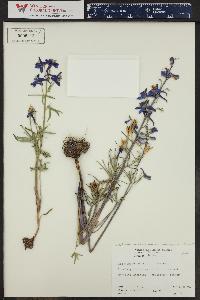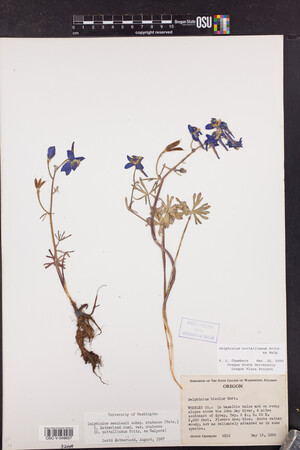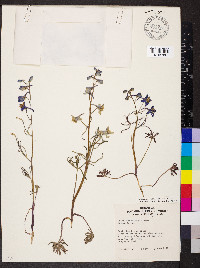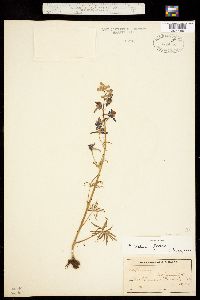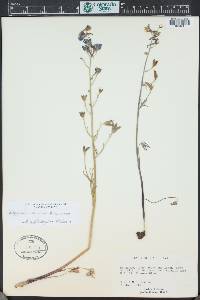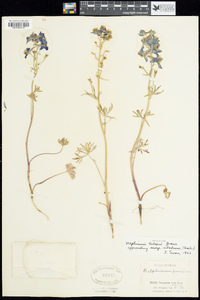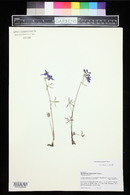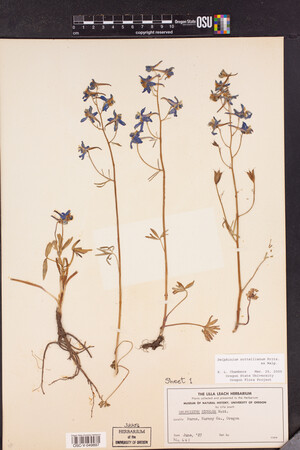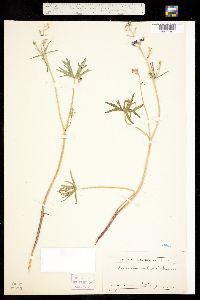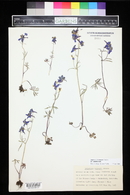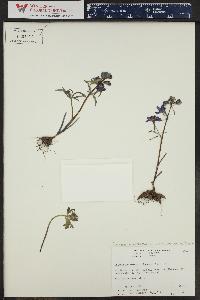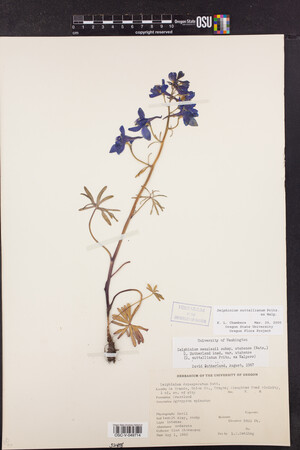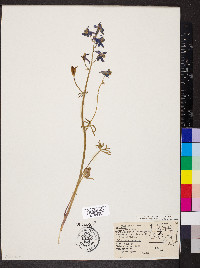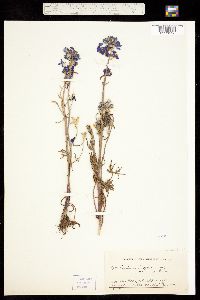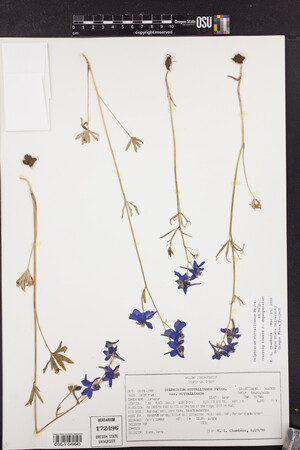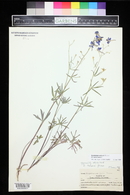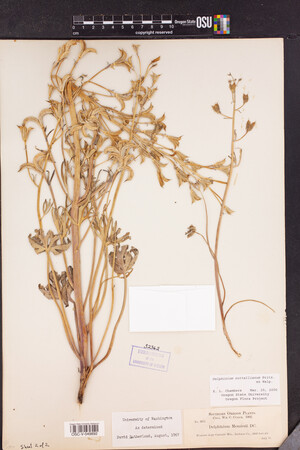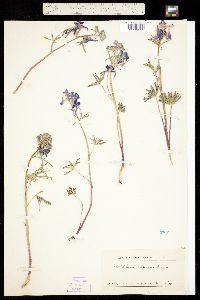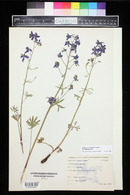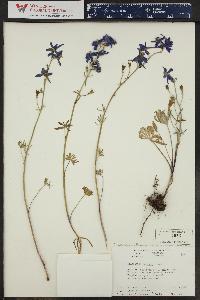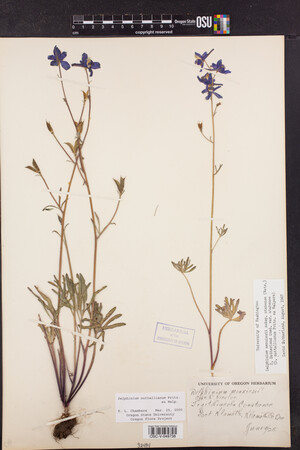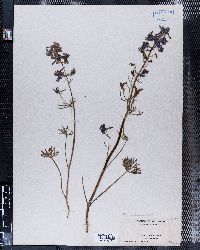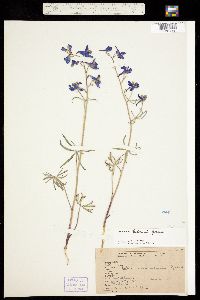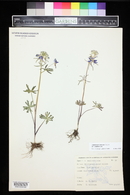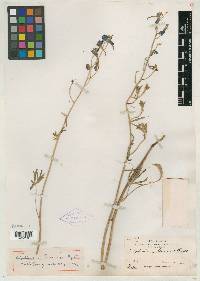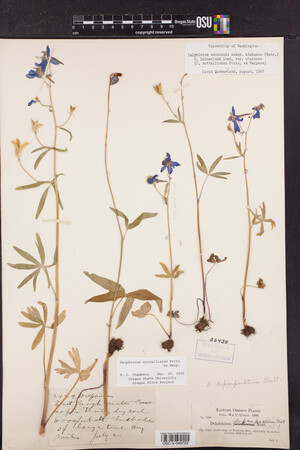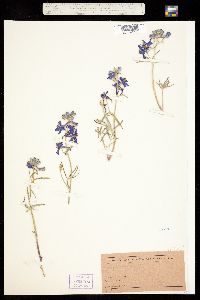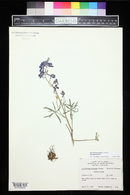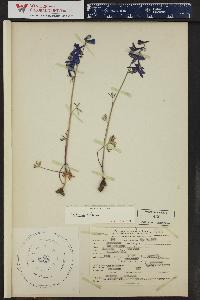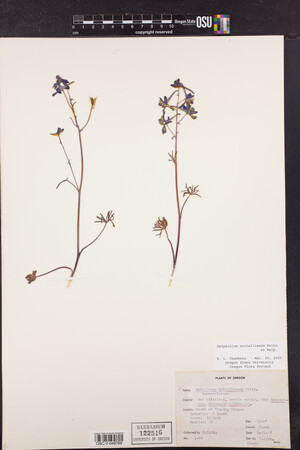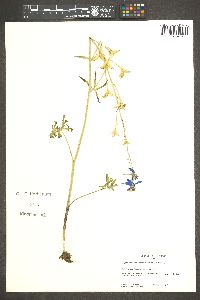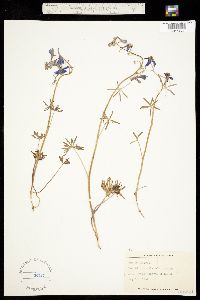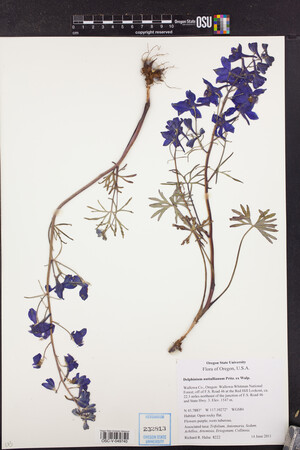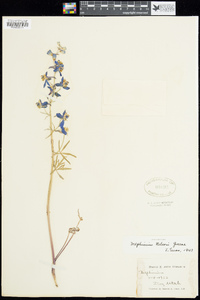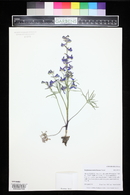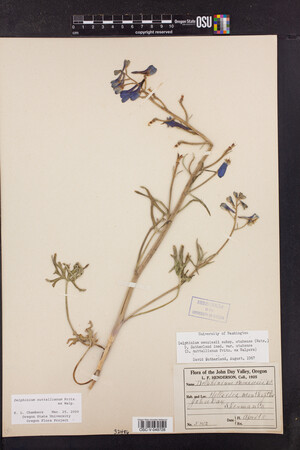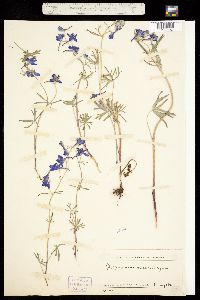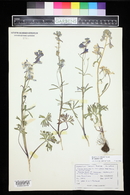Delphinium nuttallianum
|
|
|
|
Family: Ranunculaceae
Two-Lobe Larkspur, more...twolobe larkspur, low larkspur, Nuttal's larkspur, Nuttall larkspur, Nuttall's larkspur, yellow larkspur
[Delphinium bicolor var. nelsonii (Greene) K. C. Davis, moreDelphinium leonardii , Delphinium menziesii var. utahense S.Watson, Delphinium nelsonii Greene, Delphinium nelsonii subsp. utahense (S. Wats.) Ewan, Delphinium nuttallianum var. fulvum C.L. Hitchc., Delphinium nuttallianum var. levicaule C.L. Hitchc., Delphinium nuttallianum var. pilosum , Delphinium pinetorum , Delphinium sonnei Greene] |
Stems unbranched, 10-40(-70) cm; base reddish, pubescence variable. Leaves mostly on proximal 1/4 of stem; basal leaves 2-6 at anthesis; cauline leaves 2-10 at anthesis; petiole 0.4-12 cm. Leaf blade round, 1-6 × 2-12 cm, nearly glabrous; ultimate lobes 5-21, 5 or more extending more than 3/5 distance to petiole, width 1-7(-14) mm (basal), 0.5-6 mm (cauline), widest at middle or in proximal 1/2. Inflorescences 4-18(-48)-flowered, at least 2 times as long as wide; pedicel 0.8-6 cm, pubescence variable; bracteoles 3-8(-18) mm from flowers, green to blue, linear, 3-7 mm, pubescence variable. Flowers: sepals usually bluish purple, rarely white to pink, puberulent, lateral sepals reflexed or spreading, 8-21 × 3-10 mm, spurs decurved to straight, ascending 20-60° above horizontal, 8-23 mm; lower petal blades elevated, exposing stamens, blue to purple, except sometimes in white-flowered plants, 4-11 mm, clefts 2-5 mm; hairs mostly on inner lobes below junction of blade and claw, white, rarely yellow. Fruits 7-22 mm, 3.5-5 times longer than wide, glabrous to puberulent. Seeds winged or not; seed coat cell surfaces smooth or roughened, blunt hairs absent. 2 n = 16. Flowering spring (-early summer). Open coniferous woods, grassy sage scrub, meadow edges and well drained streamsides (generally not in very wet sites); 300-3500 m; B.C.; Ariz., Calif., Colo., Idaho, Mont., Nev., N.Mex., Oreg., Utah, Wash., Wyo. Delphinium nuttallianum represents an extremely difficult complex, with many variations in a number of morphologic traits. The complex has been and continues to be a major source of confusion for identification of Delphinium in North America. Type specimens of D . nuttallianum represent plants growing under dry conditions in open areas. These are typically found at 1200-2000 m in sage scrub or lower montane forest. Delphinium nuttallianum may be confused with D . andersonii , D . antoninum , D . depauperatum , D . gracilentum , and two subspecies of D . patens (subsp. patens and subsp. montanum ). Features that may be used to separate D . nuttallianum from the first four, are enumerated under the respective species discussions. From D . patens subsp. patens , D . nuttallianum may be distinguished by its narrower leaf lobes, larger fruits, and more compact inflorescence. The frequent presence of glandular hairs in the inflorescence of D . patens subsp. montanum , contrasted with their absence in D . nuttallianum , will separate these taxa. Dwarfed plants of D . polycladon may be confused with D . nuttallianum . The latter, however may be distinguished by its ringed seeds, and it does not have prominent buds or sigmoid pedicel. Hybrids have been seen between Delphinium nuttallianum and D . andersonii , D . depauperatum ( D . × burkei Greene), D . distichum ( D . × diversicolor Rydberg), D . nudicaule , and D . polycladon .
General: Perennial, 10-40 (70) cm tall; stems usually solitary, simple, base reddish, pubescence variable; stems separating easily from the roots. Leaves: Basal and cauline, mostly on the lower 1/4 of the stem, alternate, circular in outline, 1-6 cm long, 2-12 cm wide, nearly glabrous, lobes 5-12, 1-7 (14) mm wide (basal), 0.5-6 mm wide (cauline), the ultimate margins entire to lobed; petiole 0.4-12 cm long. Flowers: Inflorescence a raceme, 20-90 flowered, dense; pedicels ascending to spreading, 1-2 cm long, puberulent; flowers bilateral; sepals 5, dark blue to purple, puberulent, the lateral 2 spreading to slightly forward pointing, 10-14 mm long, the spur ascending or downcurved at the tip, 12- 15 mm long; petals 4, the lower ones slightly elevated and more-or-less exposing the stamens, white; pistils 3; flowers July-September. Fruits: Aggregate of follicles, 7-22 mm long, 3.5-5 times as long as wide; seeds numerous, dark brown, surfaces smooth or roughened. Ecology: Meadows, streambanks, ponderosa pine and mixed conifer forests, montane habitats; 1800-2600 m (6000-8500 ft); Apache, Coconino, Gila, Mohave, Navajo, and Yavapai counties; western United States. Notes: Delphinium scaposum (tall mountain larkspur) [=D. andersonii var. scaposum] is 25-60 (65) cm tall; stems are glabrous, glaucous; leaves are mostly basal, although sometimes a few cauline blades are present; the blades are circular in outline, 0.5-4 cm long, 0.5-6 cm wide, glabrous to puberulent, with 3-9 lobes; racemes are mostly 10-25 flowered, sometimes more; sepals are bright dark blue, glabrous; and the fruit is 12-16 mm long, 2.5- 3 times longer than wide. It mostly occurs in pinyon- juniper woodlands and grasslands, but is known to occur within our range. Editor: Springer et al. 2008 |
|
|
|

